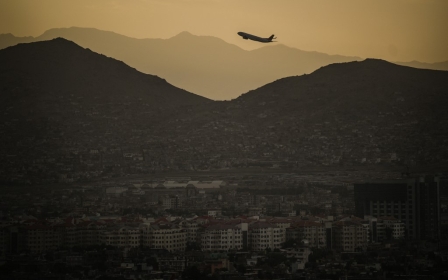Afghan refugees routinely killed by gunfire while trying to cross into Iran and Turkey, report says

A new Amnesty International report has found that Afghan refugees have consistently come under fire while trying to cross into Iran and Turkey in the year since the Taliban retook control of Afghanistan.
The report, ‘They Don’t Treat Us Like Humans,’ consists of interviews with 74 Afghans who had been pushed back by border forces and officials in both nations. More than half reported coming under fire by border guards.
Amnesty’s findings fall in line with reports in Afghan media as well as the personal accounts of Afghans in Kabul and Istanbul shared with the MEE over the last year. In February, officials in the Afghan provinces of Nimroz and Herat — both of which border Iran — told local media that hundreds of Afghans had faced physical violence when trying to enter Iran.
'They were targeting the people, absolutely'
- Saif Afghan, refugee
In Nimroz, which is a major hub for the smuggling of undocumented people and goods, officials said that nearly 100 Afghans have been shot dead by Iranian forces. Amnesty was able to verify 11 such killings that took place between April 2021 and January 2022. The youngest identified case was a 16-year-old boy.
Amnesty said the lack of official statistics means their count is very likely to be an underestimation of the violence Afghans face when trying to enter or travel through Iran. The London-based rights group says that humanitarian workers and Afghan doctors recorded at least 59 deaths and 31 injuries between August and December 2021 alone.
“The true death toll is likely to be significantly higher,” the report said.
A refugee rights worker in Europe, who could not be identified due to the nature of his job, agrees with Amnesty’s assessment, saying despite getting hundreds of calls for help a week, he is rarely told directly about physical violence by the authorities in countries they are trying to enter.
“These people are afraid, they’ve been traumatized, so they’re afraid to reveal too much about their experiences.”
This fear, said the refugee worker, is likely to keep many Afghans saying outright the violence and intimidation they were likely to face in Iran or Turkey.
Saif Afghan, a 24-year-old Afghan refugee from the Northern province of Balkh, said he saw the violence of Iranian border forces firsthand last winter.
“As soon as you got close to the Iranian side of the border, their Police would start shooting directly at people. It was very clear that they were aiming at the actual people, this wasn’t just aerial fire,” Afghan told the Middle East Eye from the city of Mazar-e Sharif.
“They were targeting the people, absolutely,” Afghan said.
Intimidation and harassment
Those Afghans who managed to make it to into Iran would then be susceptible to abuse and discrimination both by the Iranian people and officials in Tehran. These abuses have been consistently documented by rights groups over the years.
Because of this intimidation and harassment, most Afghans try to cross the border into Turkey, with the hopes of trying to enter the European Union. Amnesty says Afghans are also highly likely to come under fire from border forces in Turkey.
Of the 35 people who tried to enter Turkey that Amnesty interviewed, 23 reported coming under fire. Last May, a group of young Afghan deportees at Istanbul International recounted their stories of being shot at by Turkish border police in Van province. At least one showed visible signs of injury he said he sustained in the shooting.
Afghan, the refugee from Balkh province, says he also witnessed the “brutality” of Turkish border police when he was trying to enter Van province, on the border with Iran, “I saw them attacking the people, beating them. They had no regard if they were hitting a man a woman or a child, they just went on hitting and beating people.”
Afghan confirms that he witnessed Turkish forces physically attacking refugees, but says he only ever saw them shooting into the air to disburse the crowds of people. However, Mahmut Kacan, a lawyer who specialises in human rights and refugee issues in Turkey, verified to the MEE that several of the Afghans he represents had reported coming under fire while trying to enter the country.
Though Tehran never ceased deportation of Afghan refugees, even while the Taliban were overtaking entire districts and provinces last summer, Ankara only restarted its deportations at the start of 2022.
Currently, neither country recognizes the Taliban’s Islamic Emirate as the official government of Afghanistan, but both have deported thousands of Afghans over the last year. In May, Turkey’s Migration Management Directorate reported that the deportations of at least 10,763 Afghans in 2022.
Travel agencies, passengers and taxi drivers in Istanbul and Kabul confirmed to the MEE that both of Afghanistan’s currently operating airlines routinely transport Afghan deportees on commercial and charter flights from Turkey.
An Afghan businessman who frequently travels between Istanbul and Kabul told the MEE that he has seen deportees on every flight he’s boarded in 2022. He said that since the spring, he has been on commercial flights where as many as 80 percent of the passengers were deportees.
Tehran’s deportation drive has been much more active. According to the Afghan Ministry of Refugees and Repatriation, at least 5,600 Afghans were forcibly removed from Iran during a single week in July.
Middle East Eye propose une couverture et une analyse indépendantes et incomparables du Moyen-Orient, de l’Afrique du Nord et d’autres régions du monde. Pour en savoir plus sur la reprise de ce contenu et les frais qui s’appliquent, veuillez remplir ce formulaire [en anglais]. Pour en savoir plus sur MEE, cliquez ici [en anglais].




